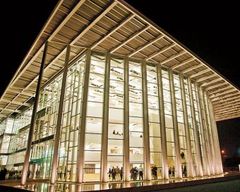Everywhere, state governments are cutting spending, including arts budgets and education budgets. What does this mean for college museums and arts centers?
 The other day, the Chronicle of Higher Education published a somewhat contrarian article headlined In an Era of Campus Cutbacks, Performing-Arts Centers Keep Going Up. It led off with the opening of the Valley Performing Arts Center at Cal State, Northridge (left), which happened just about the time California was slashing its higher education budget by $1.4 billion.
The other day, the Chronicle of Higher Education published a somewhat contrarian article headlined In an Era of Campus Cutbacks, Performing-Arts Centers Keep Going Up. It led off with the opening of the Valley Performing Arts Center at Cal State, Northridge (left), which happened just about the time California was slashing its higher education budget by $1.4 billion.
Of course, these centers were begun a long time ago. But read on:
Multimillion-dollar venues, many of them financed largely by state money, are opening or planned at colleges across the country….prompt[ing] critics to talk about “edifice complexes” and “conspicuous consumption.”
…In February, James Madison University opened its five-venue, $82-million Forbes Center for the Performing Arts. Smaller facilities have opened within the past year or so at George Mason University’s branch campus in Manassas, Va. ($46-million), Sam Houston State University ($38.5-million), and on Montgomery College’s campus in Silver Spring, Md. ($31-million).
…But even with the economy sputtering and gloom pervading legislative budget committees, new arts venues are in the works at institutions as diverse as Hagerstown Community College, in Maryland; the University of Texas’s Permian Basin campus; and the State University of New York at Potsdam. With colleges everywhere raising tuition and cutting programs, such projects have some people questioning administrative priorities.
The article goes on to say that some people now thing that art centers are a “necessity,” not a luxury, for colleges, while others wonder whether this is part of the oversupply (glut?) in the arts that National Endowment for the Arts chairman Rocco Landesman spoke about recently.
The Chronicle hasn’t done a recent survey on museums, but we do know of some recent or planned openings, including the Broad Art Museum at Michigan State, the interdisciplinary Granoff Center at Brown, and Dartmouth’s abuilding visual arts center.
I think a couple of things are going on here, starting with the fact that donors still prefer to contribute to capital campaigns than operating funds or endowments — which makes for more buildings.
At the same time, I hear — anecdotally — that university museums are being pressed to prove their worth, and often that means getting more attendance from people outside the university community. Not enough visitors = possible support cuts, which is kind of crazy considering that university museums tend to be free (still, right?).
College performing arts centers often serve the surrounding community, too — necessarily in some cases, because they are quite big.
But for museums, going too far beyond the campus may be bad because it will undoubtedly affect exhibition programming, leading it away from scholarship and more toward popular exhibits. And more visitors usually increases costs.
Just this weekend, when I read the annual Museums section in The New York Times — published on Mar. 17, while I was out of the country — it was noticeable how many university museums took out ads: I counted 11, from full page to tiny boxes. Last year’s edition carried four ads from university museums. That’s a change in outreach.
I know I am mixing public and private institutions here, but the repercussions are likely to be similar: additional dependence on private donors, and more pressure on college museums and arts centers to attract visitors from a broader community.
Photo Credit: Courtesy of Cal State, Northridge
